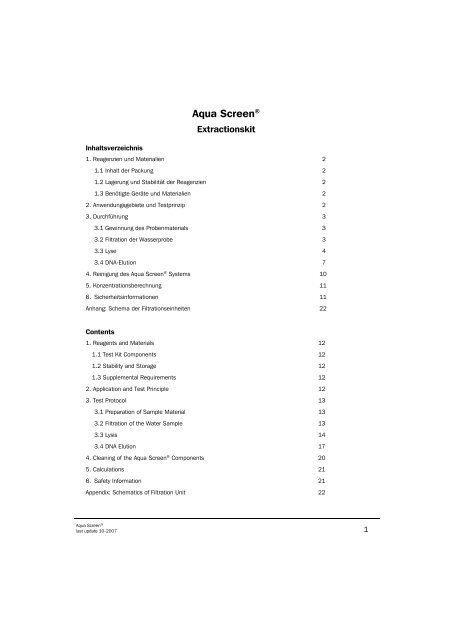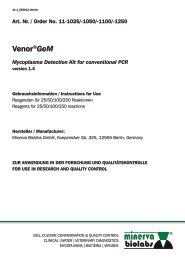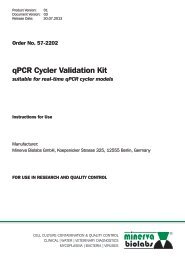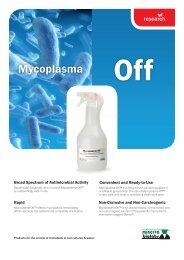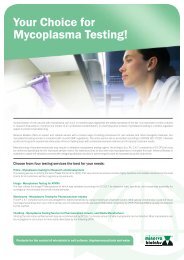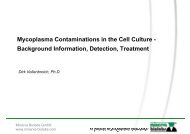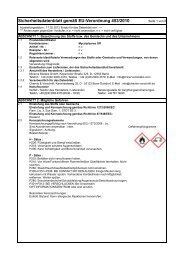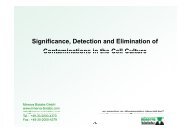Aqua Screen® - Minerva Biolabs
Aqua Screen® - Minerva Biolabs
Aqua Screen® - Minerva Biolabs
Sie wollen auch ein ePaper? Erhöhen Sie die Reichweite Ihrer Titel.
YUMPU macht aus Druck-PDFs automatisch weboptimierte ePaper, die Google liebt.
<strong>Aqua</strong> Screen ®<br />
Extractionskit<br />
Inhaltsverzeichnis<br />
1. Reagenzien und Materialien 2<br />
1.1 Inhalt der Packung 2<br />
1.2 Lagerung und Stabilität der Reagenzien 2<br />
1.3 Benötigte Geräte und Materialien 2<br />
2. Anwendungsgebiete und Testprinzip 2<br />
3. Durchführung 3<br />
3.1 Gewinnung des Probenmaterials 3<br />
3.2 Filtration der Wasserprobe 3<br />
3.3 Lyse 4<br />
3.4 DNA-Elution 7<br />
4. Reinigung des <strong>Aqua</strong> Screen ® Systems 10<br />
5. Konzentrationsberechnung 11<br />
6. Sicherheitsinformationen 11<br />
Anhang: Schema der Filtrationseinheiten 22<br />
Contents<br />
1. Reagents and Materials 12<br />
1.1 Test Kit Components 12<br />
1.2 Stability and Storage 12<br />
1.3 Supplemental Requirements 12<br />
2. Application and Test Principle 12<br />
3. Test Protocol 13<br />
3.1 Preparation of Sample Material 13<br />
3.2 Filtration of the Water Sample 13<br />
3.3 Lysis 14<br />
3.4 DNA Elution 17<br />
4. Cleaning of the <strong>Aqua</strong> Screen ® Components 20<br />
5. Calculations 21<br />
6. Safety Information 21<br />
Appendix: Schematics of Filtration Unit 22<br />
<strong>Aqua</strong> Screen ®<br />
last update 10-2007 1
1. Reagenzien und Materialien<br />
1.1 Inhalt der Packung<br />
Arbeitsanleitung<br />
für 15 Extraktionen<br />
für 50 Extraktionen<br />
Membran Filter (Membranfilter) 15 50<br />
Spin Columns (Spincolumns) 15 50<br />
Sample Storage Tubes<br />
(Eluat-Auffangröhrchen)<br />
15 50<br />
Lysis Buffer (Lysepuffer) 8 ml 30 ml<br />
Proteinase K 0,4 ml 1,50 ml<br />
Equilibration Buffer* (Equilibrierungspuffer) 8 ml 30 ml<br />
Wash Buffer 1* (Waschpuffer 1)<br />
60 ml nach Zugabe von<br />
34 ml Ethanol<br />
220 ml nach Zugabe von<br />
125 ml Ethanol<br />
Wash Buffer 2 † (Waschpuffer 2)<br />
8 ml nach Zugabe von<br />
5,6 ml Ethanol<br />
Elution Buffer (Elutionspuffer) 2 ml 6 ml<br />
Pinzette 1 1<br />
28 ml nach Zugabe von<br />
20 ml Ethanol<br />
( † ) Enthält Natriumazid als Konservierungsmittel. Bitte verwenden Sie beim Umgang mit Chemikalien immer einen Laborkittel, Schutzbrille und<br />
Einmalhandschuhe.<br />
(*) Enthält chaotrophes Salz. Reizend! Sicherheitsmassnahmen beachten! Keine Bleichmittel zur Desinfektion verwenden.<br />
1.2 Lagerung und Stabilität der Reagenzien<br />
Alle Reagenzien und Materialien werden bei +2 °C bis +8 °C gelagert. Bei vorschriftsmäßiger Lagerung sind<br />
die ungeöffneten Reagenzien bis zum angegebenen Haltbarkeitsdatum verwendbar. Nach erstmaligem<br />
Gebrauch müssen die geöffneten Reagenzien innerhalb von 2 Monaten verwendet werden. Vor der ersten<br />
Benutzung muss zu den Waschpuffern 1 und 2 Ethanol (96-100%) in den oben angegebenen Volumina<br />
hinzu gegeben werden. Vor der Verwendung bitte alle Reagenzien auf Raumtemperatur (+18 °C bis +25 °C)<br />
bringen.<br />
1.3 Benötigte Geräte und Materialien<br />
Vakuumpumpe<br />
Mikrozentrifuge<br />
Mikroliterpipetten und Filterspitzen<br />
Ethanol (96-100%)<br />
2<br />
D E U T S C H<br />
<strong>Aqua</strong> Screen ®<br />
last update 10-2007
3. Durchführung<br />
3.1 Gewinnung des Probenmaterials<br />
Die Probennahme beeinflusst die Zuverlässigkeit der Testbefunde und muss entsprechend den Anforderungen<br />
der Gesundheitsämter bzw. des Arbeitsblattes W552 des DVGW erfolgen. Die Wasserprobe muss ungekühlt<br />
innerhalb von 48 h der Untersuchung zugeführt werden. Eine Konservierung mit chemischen Mitteln ist<br />
nicht möglich, da für die Filtration intakte Mikroorganismenpartikel benötigt werden. Mit Schwebstoffen oder<br />
festen Bestandteilen belastete Wasserproben werden durch Vorfiltration mit einem Papierfaltenfilter geklärt.<br />
Die Proben dürfen zur Klärung nicht zentrifugiert werden. Für die Untersuchung werden mindestens 100 ml<br />
Wasser benötigt. Ein Testvolumen von 1000 ml wird empfohlen. Durch erneutes Befüllen des Glastrichters<br />
können auch größere Probenvolumina untersucht werden. In der Probe enthaltene freie DNA von abgestorbenen<br />
und bereits lysierten Mikroorganismen passiert den Membranfilter und ist im Test nicht nachweisbar.<br />
Der Test weist lebende kultivierbare und lebende aber nicht kultivierbare (VBNC, viable but not culturable)<br />
Legionellen in gleicher Weise nach. Die Keime, die mit dem herkömmlichen Agarplattenverfahren nicht<br />
nachgewiesen werden können (VBNC), werden durch das <strong>Aqua</strong> Screen ® System erfasst.<br />
3.2 Filtration der Wasserprobe<br />
1. Ein Membranfilter wird vorsichtig mit der mitgelieferten<br />
Pinzette aus der Verpackung entnommen<br />
und für einige Sekunden mit der Probe befeuchtet.<br />
Der Aufbau der Filtrationseinheit ist auf Seite<br />
22 dargestellt. Der Aufbau für die Schritte<br />
3.2.2 - 3.2.5 erfolgt nach dem Schema 1 und<br />
für die Schritte 3.4.1 - 3.4.6 nach dem<br />
Schema 2.<br />
2. Der Membranfilter wird in den Filterhalter eingelegt<br />
und die beiden Hälften des Filterhalters mit der<br />
Dichtung über der Membran zusammengeschraubt.<br />
Die obere Kammer des Filterhalters wird<br />
bis zum oberen Rand mit Probenwasser befüllt<br />
(ca. 1700 µl). Der Adapter wird auf den Absaugplatz<br />
gesteckt. Dabei ist das Ventil des Absaugplatzes<br />
zu schließen. Der befüllte Filterhalter wird<br />
auf den Adapter gesteckt (obere Kammer nach<br />
oben zeigend).<br />
<strong>Aqua</strong> Screen ®<br />
last update 10-2007 D E U T S C H 3
3. Der Glastrichter wird von oben auf den Filterhalter gesteckt und mit dem gewünschten Volumen an<br />
Probenwasser befüllt.<br />
4. Das Ventil wird geöffnet und die Vakuumpumpe eingeschaltet.<br />
5. Nach erfolgter Filtration wird das Ventil geschlossen und die Vakuumpumpe abgestellt.<br />
Im Filterhalter darf sich keine Flüssigkeit mehr befinden!<br />
3.3 Lyse<br />
Die Puffer müssen auf Raumtemperatur gebracht werden!<br />
1. Der Filterhalter wird abgenommen und der untere Auslass mit einem Verschlussstopfen verschlossen.<br />
4<br />
D E U T S C H<br />
<strong>Aqua</strong> Screen ®<br />
last update 10-2007
2. In die obere Filterhalterkammer werden<br />
500 µl Lysepuffer<br />
25 µl Proteinase K<br />
pipettiert und die Kammer mit einem Verschlussstopfen verschlossen.<br />
3. Der Inhalt des Filterhalters wird durch kräftiges Schütteln oder Vortexen homogenisiert. Anschließend<br />
wird der Filterhalter senkrecht (Einlass nach oben) gestellt und für 30 min bei Raumtemperatur inkubiert.<br />
<strong>Aqua</strong> Screen ®<br />
last update 10-2007 D E U T S C H 5
4. Der obere Verschlussstopfen wird vorsichtig abgenommen. In die obere Filterhalterkammer werden<br />
500 µl des Equilibrierungspuffers pipettiert, der obere Verschlussstopfen wieder befestigt, der Inhalt<br />
durch mehrmaliges intensives Schütteln durchmischt und erneut für 30 min bei Raumtemperatur inkubiert.<br />
5. Der obere Verschlussstopfen wird vorsichtig abgenommen. In die obere Filterhalterkammer werden<br />
500 µl Ethanol (96-100%) pipettiert, der obere Verschlussstopfen wird wieder befestigt und der Inhalt<br />
durch mehrmaliges intensives Schütteln durchmischt.<br />
6<br />
D E U T S C H<br />
<strong>Aqua</strong> Screen ®<br />
last update 10-2007
3.4 DNA-Elution<br />
1. Der Adapter wird von der Absaugbank genommen und das Spincolumn eingesetzt. Der Adapter wird in<br />
das Spincolumn gesteckt. (vgl. Schema 2 auf Seite 22).<br />
2. Der untere Verschlussstopfen wird vom Filterhalter entfernt und der untere Auslass in den Adapter gesteckt.<br />
<strong>Aqua</strong> Screen ®<br />
last update 10-2007 D E U T S C H 7
3. Der obere Verschlussstopfen wird vom Filterhalter entfernt, die obere Kammer des Filterhalters mit<br />
Waschpuffer 1 bis zum oberen Rand befüllt (ca. 900 µl) und der Kunststofftrichter in die Einlassöffnung<br />
des Filterhalters gesteckt.<br />
4. Der Kunststofftrichter wird mit 3 ml Waschpuffer 1 befüllt.<br />
8<br />
D E U T S C H<br />
<strong>Aqua</strong> Screen ®<br />
last update 10-2007
5. Das Vakuum wird angelegt und das Ventil der Absaugbank geöffnet.<br />
Versuchen Sie nicht Teile von der Absaugbank abzunehmen, während noch Vakuum anliegt<br />
bzw. das Ventil nicht verschlossen ist! Die Probe kann sonst vollständig verloren gehen.<br />
6. Nachdem die Flüssigkeit aus dem Kunststofftrichter und dem Filterhalter abgesaugt wurde, wird das<br />
Ventil der Absaugbank verschlossen und das Vakuum abgestellt. Der Filterhalter und der Adapter werden<br />
abgenommen.<br />
Das Spincolumn langsam und vorsichtig entnehmen, um ein eventuell noch bestehendes<br />
Vakuum langsam zu belüften. Die Probe kann sonst verloren gehen.<br />
7. Das Spincolumn wird in das dazugehörige Auffanggefäß gegeben und für 1 min bei 8.000 rpm (bzw.<br />
6.000 rcf) zentrifugiert, um Reste des Waschpuffers 1 zu entfernen.<br />
8. In das Spincolumn werden 500 µl Waschpuffer 2 hineingegeben.<br />
9. Das Spincolumn wird mit dem Auffanggefäß für 3 min bei 13.200 rpm (bzw. 16.100 rcf) zentrifugiert,<br />
um den Waschpuffer 2 abzutrennen.<br />
10. Das Spincolumn wird in das mitgelieferte 1,5 ml Auffangröhrchen gegeben und der Waschpuffer 2<br />
samt Auffangröhrchen verworfen.<br />
11. Es werden 60 µl Elutionspuffer in das Spincolumn pipettiert. Anschließend wird es verschlossen und<br />
für 5 min bei Raumtemperatur inkubiert.<br />
12. Nach der Inkubation wird das System für 1 min bei 8.000 rpm (bzw. 6.000 rcf) sowie 20 sec bei<br />
13.200 rpm (bzw. 16.100 rcf) zentrifugiert.<br />
13. Das Spincolumn wird entfernt und 5 µl des Eluats direkt in der PCR eingesetzt. Der Extrakt ist bei<br />
+2 °C bis +8 °C für ca. 1 Woche stabil und kann bei mindestens -18 °C gelagert werden.<br />
<strong>Aqua</strong> Screen ®<br />
last update 10-2007 D E U T S C H 9
4. Reinigung des <strong>Aqua</strong> Screen ® Systems<br />
Alle Komponenten der Filtrationseinheit sind wieder verwendbar und sollten vor einem erneuten Einsatz<br />
gereinigt werden. Es müssen Verunreinigungen durch vitale, infektiöse Keime und durch Legionellen-DNA<br />
unterschieden werden.<br />
Desinfektion des Systems (optional)<br />
Bis auf das Gestell sind alle Bestandteile der Filtrationseinheit bei 123 °C für 20 min. autoklavierbar:<br />
Am Glastrichter muss die Verschraubung am Auslass vor dem Autoklavieren leicht gelöst werden. Der Filterhalter<br />
muss aufgeschraubt autoklaviert werden. Verwendete Filtermembranen müssen vorher entfernt<br />
und getrennt entsorgt werden. Kunststofftrichter, Verschlussstopfen und Adapter können direkt autoklaviert<br />
werden.<br />
Das Filtrationsgestell kann mit Desinfektionsmitteln besprüht und abgewischt werden. Es eignen sich<br />
Desinfektionsmittel auf alkoholischer oder aldehydischer Basis sowie mit quaternären Ammoniumverbindungen.<br />
Bleichmittel sollten nicht verwendet werden.<br />
Zur Desinfektion der Innenbereiche des Filtrationsgestells und der Rohrleitungen wird der Adapter auf den<br />
Adaptersitz gesteckt. Das Desinfektionsmittel kann über den Trichter durch kurzfristiges Anlegen des Vakuums<br />
in das System eingebracht werden.<br />
Nach der Desinfektion der Systembestandteile ist dringend eine Reinigung erforderlich.<br />
Reinigung des Systems<br />
Nach jeder Untersuchung muss eine gründliche Reinigung aller mit der Probe in Kontakt gekommenen Teile<br />
erfolgen, um eine Verschleppung von DNA zu vermeiden:<br />
Der Glastrichter sowie die Einzelteile des Auslasses, der auseinander geschraubte Filterhalter, die Verschlussstopfen<br />
und der Adapter können mit <strong>Aqua</strong> Screen ® Cleaner (Bestellnr. 35-1025) behandelt werden,<br />
um anhaftende DNA zu zerstören. Bei der Verwendung von <strong>Aqua</strong> Screen ® Cleaner sind Einmalhandschuhe,<br />
Laborkittel und Schutzbrille zu tragen.<br />
Die Reste der Dekontaminationslösung müssen mit ausreichend DNA-freiem Wasser entfernt werden. Die<br />
Glastrichter können im Geschirrspüler oder per Hand mit laborüblichen Reinigungsmitteln (z.B. Spülmittel)<br />
gereinigt werden. Kleinteile werden direkt mit DNA-freiem Wasser abgespült.<br />
Nach der Reinigung werden die Bestandteile vollständig mit Papierhandtüchern getrocknet, um eventuell im<br />
Spülwasser enthaltene Legionellen abzutragen. Lufttrocknung sollte aus diesem Grund vermieden werden.<br />
Zusammenbau<br />
Sollte das Lochsieb während der Reinigung heraus gefallen sein, so muss beim Wiedereinsetzen die geriffelte<br />
Seite nach oben (zur Membran) zeigen und das Lochsieb in den unteren Teil des Filterhalters (Auslass)<br />
eingesetzt wird.<br />
Eine Sterilisation der Materialien vor Gebrauch ist nicht notwendig, da keine Anzucht der Mikroorganismen<br />
erfolgt.<br />
10<br />
D E U T S C H<br />
<strong>Aqua</strong> Screen ®<br />
last update 10-2007
5. Konzentrationsberechnung<br />
Die in der Probe enthaltene Konzentration an Legionellengenome (nicht zu vergleichen mit koloniebildenden<br />
Einheiten, KBE) kann bei einer anschließenden quantitativen real-time PCR-Analyse von 5 µl des Extraktes<br />
und einer Standardkurve (Artikel Nr. 52-0101) folgendermaßen berechnet werden:<br />
Genome/PCR x 12 x 1000<br />
Probenvolumen in [ml]<br />
= Legionellenpartikel pro Liter<br />
Beispiel: 500 ml Probenwasser werden für die Untersuchung verwendet. Die real-time PCR ergibt eine Konzentration<br />
von 30 DNA-Kopien pro Testvolumen (5 µl).<br />
30 Kopien/PCR x 12 x 1000<br />
500 ml<br />
= 720 Legionellenpartikel pro Liter<br />
Im Probenvolumen von 500 ml befanden sich ca. 360 intakte Legionellenpartikel (lebende kultivierbare,<br />
lebende jedoch nicht kultivierbare und tote jedoch intakte Legionellen).<br />
6. Sicherheitsinformationen<br />
Immer Einmalhandschuhe, Laborkittel und Schutzbrille tragen.<br />
Mischen Sie keine säurehaltigen oder bleichenden Mittel mit dem Flüssigabfall.<br />
Bestandteile des Lysepuffers, des Equilibrierungspuffers und des Waschpuffers 1 können mit Bleichmitteln<br />
oder säurehaltigen Lösungen hochreaktive Verbindungen bilden. Ausgelaufene oder verschütte Reste können<br />
mit Wasser und Spülmittel entfernt werden.<br />
Risiko– und Sicherheitssätze für Lysepuffer, Equilibrierungspuffer und Waschpuffer 1:<br />
R 22<br />
R 36/38<br />
R 36/37/38<br />
S 36/37<br />
S 36/37/39<br />
S 13<br />
S 26<br />
S 36<br />
S 46<br />
Gesundheitsschädlich beim Verschlucken.<br />
Reizt die Augen und die Haut.<br />
Reizt die Augen, Atmungsorgane und die Haut.<br />
Bei der Arbeit geeignete Schutzhandschuhe und Schutzkleidung tragen.<br />
Bei der Arbeit geeignete Schutzkleidung, Schutzhandschuhe und Schutzbrille/Gesichtsschutz tragen.<br />
Von Nahrungsmitteln, Getränken und Futtermitteln fernhalten.<br />
Bei Berührung mit den Augen sofort gründlich mit Wasser abspülen und Arzt konsultieren.<br />
Bei der Arbeit geeignete Schutzkleidung tragen.<br />
Bei Verschlucken sofort ärztlichen Rat einholen und Verpackung oder Etikett vorzeigen.<br />
<strong>Aqua</strong> Screen ®<br />
last update 10-2007 D E U T S C H 11
1. Reagents and Materials<br />
1.1 Test Kit Components<br />
Instruction Manual<br />
für 15 units<br />
für 50 units<br />
Membran 15 50<br />
Spin Columns 15 50<br />
Sample Storage Tubes 15 50<br />
Lysis Buffer 8 ml 30 ml<br />
Proteinase K 0,4 ml 1,50 ml<br />
Equilibration Buffer* 8 ml 30 ml<br />
Wash Buffer 1* 60 ml add 34 ml Ehanol 220 ml add 125 ml Ethanol<br />
†<br />
Wash Buffer 2 8 ml add 5,6 ml Ethanol 28 ml add 20 ml Ethanol<br />
Elution Buffer 2 ml 6 ml<br />
Tweezers 1 unit 1 unit<br />
( † ) Contains sodium azide as a preservative. When working with chemicals, always wear a suitable lab coat, disposable gloves, and protective<br />
goggles.<br />
(*) Contains chaotropic salt, which is an irritant. Take appropriate laboratory safety measures and wear gloves when handling. Not compatible<br />
with disinfecting agents containing bleach.<br />
1.2 Stability and Storage<br />
Kit components are stable during shipping. Upon receipt, store at +2 °C to +8 °C. By following these<br />
recommendations, the kit is stable until the expiration date. Following the initial use, the reagents are to be<br />
used within 2 months. Prior to first use, add the above mentioned volumes of ethanol (96-100%) to Wash<br />
Buffer 1 and 2. Bring the reagents to room temperature (+18 °C to +25 °C) prior to use.<br />
1.3 Supplemental Requirements<br />
vacuum pump<br />
microcentrifuge<br />
micropipettes and filtered tips<br />
Ethanol (96-100%)<br />
2. Application and Test Principle<br />
<strong>Aqua</strong> Screen ® is an in vitro test system for the qualitative or quantitative detection of water pathogens. The<br />
flexibility of the test system allows for a variety of water sources to be tested. <strong>Aqua</strong> Screen ® performs the<br />
filtration of the water sample, the lysis of the precipitated microorganisms, the DNA extraction as well as the<br />
purification and elution of the DNA in minimal volumes under conditions which are optimal for the<br />
subsequent PCR analysis.<br />
12<br />
E N G L I S H<br />
<strong>Aqua</strong> Screen ®<br />
last update 10-2007
3. Test Protocol<br />
3.1 Preparation of Sample Material<br />
Drinking water, bathing or pool water and waste water released from suspended particles can be used as<br />
sample materials. The sample conditioning affects the reliability of the test findings and must be in<br />
accordance with the guidelines of the ISO Norm 11731. For additional guidelines pertaining to the water<br />
sampling procedure, please refer to ISO Norm 5667-1 to 5667-10 or contact your national environmental<br />
agency. The water samples should be kept at room temperature, and tested within two days of collection.<br />
Preservation with chemical means is not possible as intact microorganisms are needed for the filtration<br />
procedure. Water samples contaminated with suspended particles or fixed volatile contents have to be<br />
purified by filtration with a folded paper filter. The samples may not be centrifuged for purification. For the<br />
testing procedure, at least 100 ml is minimally required, however a sample volume of 1000 ml is<br />
recommended. Free DNA of already lysed microorganisms in the sample passes through the membrane<br />
filter and is not detectable in the test system. The test does not differentiate between “viable and<br />
culturable” and “viable but not culturable” (VBNC) legionella.<br />
3.2 Filtration of the Water Sample<br />
1. After carefully removing a membrane filter from<br />
the packaging with the provided tweezers, moisten<br />
the filter for a few seconds using the sample<br />
material.<br />
For assisted assembly of the Filtration Unit,<br />
please see schematic diagrams on page 22<br />
for steps 3.2.2—3.2.5, refer to Scheme 1 for<br />
step 3.4.1—3.4.6 refer to Scheme 2.<br />
2. Insert the membrane filter into the filter-holder and<br />
fasten together the two halves of the filter-holder<br />
with the seal on the membrane. Fill the upper<br />
chamber of the filter-holder (inlet) with the water<br />
sample to the top margin (approx. 1700 µl). Place<br />
the adapter on the suction bank and close the<br />
suction valve. Place the filter-holder (inlet upward)<br />
on the adapter.<br />
<strong>Aqua</strong> Screen ®<br />
last update 10-2007 E N G L I S H 13
3. Place the glass funnel on the filter-holder from above and fill with the desired volume of the water<br />
sample.<br />
4. Open the valve and activate the vacuum pump.<br />
5. After filtration, close the valve and shut down the vacuum pump.<br />
There should be no remaining liquid in the filter-holder!<br />
3.3 Lysis<br />
Bring all reagents to room temperature.<br />
1. Remove the filter-holder and secure the lower outlet with a stopper.<br />
14<br />
E N G L I S H<br />
<strong>Aqua</strong> Screen ®<br />
last update 10-2007
2. Pipette into the upper filter-holder chamber the following:<br />
500 µl Lysis buffer<br />
25 µl Proteinase K<br />
and secure the chamber with a stopper.<br />
3. Homogenize the contents of the filter-holder by vigorous vibration or vortexing. Afterwards place the<br />
filter-holder perpendicularly (inlet upward) and incubate for 30 min at room temperature.<br />
<strong>Aqua</strong> Screen ®<br />
last update 10-2007 E N G L I S H 15
4. Carefully remove the upper stopper. Pipette 500 µl of the equilibration buffer into the upper filter-holder<br />
chamber and close the upper stopper again. Mix the contents by vigorous vortexing and incubate for an<br />
additional 30 min at room temperature.<br />
5. Carefully remove the upper stopper. Pipette 500 µl of ethanol (96-100%) into the upper filter-holder<br />
chamber. Close the upper stopper and vortex vigorously for 2 min.<br />
16<br />
E N G L I S H<br />
<strong>Aqua</strong> Screen ®<br />
last update 10-2007
3.4 DNA Elution<br />
1. Remove the adapter from the suction bank, and insert a spin column into the suction bank. Place the<br />
adapter onto the spin column (refer to Scheme 2; page 22).<br />
2. Remove the lower stopper from the filter-holder and place the lower outlet into the adapter.<br />
<strong>Aqua</strong> Screen ®<br />
last update 10-2007 E N G L I S H 17
3. Remove the upper stopper from the filter-holder. Fill the upper chamber of the filter-holder (inlet) with<br />
Wash Buffer 1 to the top margin (approx. 900 µl). Place the funnel-syringe into the inlet port of the<br />
filter-holder.<br />
4. Fill the syringe with 3 ml Wash Buffer 1.<br />
18<br />
E N G L I S H<br />
<strong>Aqua</strong> Screen ®<br />
last update 10-2007
5. Activate the vacuum pump and open the valve of the suction bank.<br />
Do not attempt to remove items from suction bank while vacuum is active.<br />
6. After the liquid from the syringe has been suctioned, shut down the vacuum and close the valve of<br />
the suction bank. Remove the syringe, filter-holder and adapter<br />
Remove the spin column carefully. Relieve the vacuum slowly to avoid loss of the sample.<br />
7. Put the spin column into its receiving tube and centrifuge the system for 1 min at 8,000 rpm<br />
(6,000 rcf) in order to remove the remaining Wash Buffer 1.<br />
8. Fill the spin column with 500 µl Wash Buffer 2.<br />
9. Centrifuge for 1 min at 13,200 rpm (16,100 rcf) in order to remove the remaining Wash Buffer.<br />
10. Place the spin column into a new 1.5 ml receiving tube, and discard the receiving tube containing<br />
the Wash Buffer 2.<br />
11. Pipette 60 µl elution buffer into the spin column. Secure the receiving tube and incubate for 5 min<br />
at room temperature.<br />
12. Following the incubation, centrifuge the system for 1 min at 8,000 rpm (6,000 rcf) followed by 20<br />
sec. at 13,200 rpm (16,100 rcf).<br />
13. Remove the spin column and use the 5 µl eluate directly for the PCR procedure. The extract is<br />
stable for approximately 1 week at +2 °C to +8 °C and can be kept at -18 °C for long term storage.<br />
<strong>Aqua</strong> Screen ®<br />
last update 10-2007 E N G L I S H 19
4. Cleaning of the <strong>Aqua</strong> Screen ® components<br />
All components of the filtration unit are reusable. After each analysis, a thorough cleansing of all parts that<br />
have come in contact with the sample is necessary in order to avoid contamination by infectious<br />
microorganisms and DNA.<br />
Disinfection of the System (optional)<br />
If the sample contained biologically dangerous material, then all parts which had contact with the sample<br />
must be disinfected. All parts of the filtration unit, but not the filtration rack, can be autoclaved at 123 °C for<br />
20 min.<br />
The fittings at the outlet of the glass funnel should be slightly unfastened prior autoclaving. The filter<br />
holders should be opened and the used filter membranes are discarded separately. The funnel-syringes,<br />
stoppers and the adapters can be autoclaved directly.<br />
The filtration rack can be disinfected with standard disinfection reagents based on alcohols, aldehydes or<br />
quaternary ammonium salts. Bleach should not be used.<br />
For disinfection of the inner parts of the filtration rack and the tubing the adapter should be installed on the<br />
bench. Using the funnel and vacuum disinfection solution can be poured into the rack.<br />
After disinfection all parts need to be cleaned thoroughly.<br />
Cleaning of the System<br />
The filter holders, adapters, funnel-syringes and stoppers must be free of residual DNA. To this end, we<br />
recommend our DNA removal agent, <strong>Aqua</strong> Screen ® Cleaner (order no. 35-1025). The remainder of the<br />
decontamination solution must be removed with ample DNA-free water. During the cleaning, wear a suitable<br />
lab coat, disposable gloves, and protective goggles!<br />
The glass funnels can be cleaned from the decontamination solution e.g. in the dishwasher or by hand with<br />
cleaning agents (e.g. detergents). The filter holders, stoppers, and the adapters can be rinsed directly in DNAfree<br />
water and dried with a paper towel.<br />
Subsequently, using a paper towel all parts must be wiped dry to remove residues from the dish water. Air<br />
drying is not recommended.<br />
Reassembly<br />
Should the perforated strainer have been removed during the cleaning, then the grooved side must face<br />
upward (toward the membrane) and has to be reinserted into the lower part of the filter holder (outlet).<br />
A sterilization of the materials before use is not necessary, as an inoculation of the microorganisms does not<br />
take place.<br />
20<br />
E N G L I S H<br />
<strong>Aqua</strong> Screen ®<br />
last update 10-2007
5. Calculations<br />
With the use of quantitative real-time PCR and a standard curve generated with the titrated DNA standard<br />
(Cat. No. 52-0101), the quantity of legionella particles in the extract and subsequently in the sample<br />
volume can be determined. If a 5 µl test volume is used, then the total quantity of genomic equivalents<br />
present in the water sample can be calculated:<br />
genomes/PCR x 12 x 1000<br />
sample volume in [ml]<br />
= legionella particles per liter<br />
Example: A 500 ml water sample is used for the analysis and extracted in 60 µl. On the basis of the realtime<br />
PCR, a result of 30 DNA copies is determined using a test volume of 5 µl.<br />
30 genomes/PCR x 12 x 1000<br />
500 ml<br />
= 720 legionella particles per liter<br />
Result: In the 500 ml sample water, there were 360 intact legionella particles (viable culturable, viable but<br />
not culturable (VBNC), and dead yet still intact Legionella).<br />
6. Safety Information<br />
Always wear a suitable lab coat, disposable gloves, and protective goggles.<br />
DO NOT add bleach or acidic solutions directly to the sample-preparation waste.<br />
The sample-preparation waste contains lysis buffer, equilibration buffer and wash buffer 1, which can form<br />
highly reactive compounds when combined with bleach. If liquid containing these buffers is spilt, clean with<br />
suitable laboratory detergent and water. The risk and safety phrases applying to lysis buffer, equilibration<br />
buffer and wash buffer 1 are:<br />
R 22 Harmful if swallowed.<br />
R 36/38 Irritating to eyes and skin.<br />
R 36/37/38 Irritating to eyes, respiratory system and skin.<br />
S 36/37 Wear suitable protective clothing and gloves.<br />
S 36/37/39 Wear suitable protective clothing, gloves, and eye/face protection.<br />
S 13 Keep away from food, drink and animal feed.<br />
S 26 In case of contact with eyes, rinse immediately with plenty of water and seek medical advice.<br />
S 36 Wear suitable protective clothing.<br />
S 46 If swallowed, seek medical advice immediately and show this container or label.<br />
<strong>Aqua</strong> Screen ®<br />
last update 10-2007 E N G L I S H 21
Scheme 1:<br />
Scheme 2:<br />
22<br />
<strong>Aqua</strong> Screen ®<br />
last update 10-2007
Related Products<br />
Supplements<br />
53-0050 MB TAQ DNA Polymerase 50 units<br />
53-0100 MB TAQ DNA Polymerase 100 units<br />
53-0200 MB TAQ DNA Polymerase 200 units<br />
53-0250 MB TAQ DNA Polymerase 250 units<br />
35-1025 <strong>Aqua</strong> Screen ® Cleaner, spray bottle 250 ml<br />
35-1200 <strong>Aqua</strong> Screen ® Cleaner, refill bottles 4 x 500 ml<br />
Filtration Unit<br />
31-0300 Filtration Rack 1 unit<br />
Extraction Unit<br />
32-0150 Extraction Kit 15 extractions<br />
32-0500 Extraction Kit 50 extractions<br />
32-2000 Extraction Kit 200 extractions<br />
Diagnostic Kits for Conventional PCR<br />
33-1025 Legionella spp. Detection Kit for conv. PCR 25 tests<br />
33-1100 Legionella spp. Detection Kit for conv. PCR 100 tests<br />
33-1250 Legionella spp. Detection Kit for conv. PCR 250 tests<br />
34-1025 Legionella pneumophila Detection Kit for conv. PCR 25 tests<br />
34-1100 Legionella pneumophila Detection Kit for conv. PCR 100 tests<br />
34-1250 Legionella pneumophila Detection Kit for conv. PCR 250 tests<br />
Diagnostic Kits for Real-Time PCR<br />
33-2025 Legionella spp. Detection Kit for real-time PCR (LC1/2, ABI Prism,...) 25 tests<br />
33-2100 Legionella spp. Detection Kit for real-time PCR (LC1/2, ABI Prism,...) 100 tests<br />
33-2250 Legionella spp. Detection Kit for real-time PCR (LC1/2, ABI Prism,...) 250 tests<br />
33-3025 Legionella spp. Detection Kit for real-time PCR (SmartCycler, MX3000,ú) 25 tests<br />
33-3100 Legionella spp. Detection Kit for real-time PCR (SmartCycler, MX3000,ú) 100 tests<br />
33-3250 Legionella spp. Detection Kit for real-time PCR (SmartCycler, MX3000,ú) 250 tests<br />
33-5025 Legionella spp. Detection Kit for real-time PCR (AFNOR XP T90-471) 25 tests<br />
33-5100 Legionella spp. Detection Kit for real-time PCR (AFNOR XP T90-471) 100 tests<br />
33-5250 Legionella spp. Detection Kit for real-time PCR (AFNOR XP T90-471) 250 tests<br />
34-2025 L. pneumophila Detection Kit for real-time PCR (LC1/2, ABI Prism,...) 25 tests<br />
34-2100 L. pneumophila Detection Kit for real-time PCR (LC1/2, ABI Prism,...) 100 tests<br />
34-2250 L. pneumophila Detection Kit for real-time PCR (LC1/2, ABI Prism,...) 250 tests<br />
34-3025 L. pneumophila Detection Kit for real-time PCR (SmartCycler, MX3000,ú) 25 tests<br />
34-3100 L. pneumophila Detection Kit for real-time PCR (SmartCycler, MX3000,ú) 100 tests<br />
34-3250 L. pneumophila Detection Kit for real-time PCR (SmartCycler, MX3000,ú) 250 tests<br />
34-5025 L. pneumophila Detection Kit for real-time PCR (AFNOR XP T90-471) 25 tests<br />
34-5100 L. pneumophila Detection Kit for real-time PCR (AFNOR XP T90-471) 100 tests<br />
34-5250 L. pneumophila Detection Kit for real-time PCR (AFNOR XP T90-471) 250 tests<br />
Genomic DNA Extracts 100 µl each<br />
51-0101 Legionella pneumophila, ATCC 33152 +/- 10 ng / 100 µl<br />
51-1514 Legionella pneumophila subsp. fraseri, DSMZ 7514 +/- 10 ng / 100 µl<br />
51-1515 Legionella pneumophila subsp. pascullei, DSMZ 7515 +/- 10 ng / 100 µl<br />
51-1368 Legionella bozemanii, NC 011368 +/- 10 ng / 100 µl<br />
51-1370 Legionella dumoffii, NC 011370 +/- 10 ng / 100 µl<br />
Quantification Standards<br />
52-0101 Legionella pneumophila DNA Standard 1x10 6 genomes/µl<br />
Spare parts<br />
35-0100 Glass funnel, 1000 ml capacity 1 unit<br />
35-0110 Adapter 3 units<br />
35-0120 Membrane filter holder 3 units<br />
35-0130 Stopper 2x10 units<br />
35-0140 Funnel-syringe 3 units<br />
<strong>Aqua</strong> Screen ®<br />
last update 10-2007 23
24<br />
<strong>Aqua</strong> Screen ®<br />
last update 10-2007
<strong>Aqua</strong> Screen ®<br />
last update 10-2007 25
26<br />
<strong>Aqua</strong> Screen ®<br />
last update 10-2007
<strong>Aqua</strong> Screen ®<br />
last update 10-2007 27
<strong>Minerva</strong> <strong>Biolabs</strong>`s International Distributors<br />
Belgium, Luxemburg<br />
Lucron Bioproducts<br />
Tel.: +32 (92) 820531<br />
Fax: +32 (92) 820532<br />
E-mail: info@lucronbioproducts.com<br />
Web: www.lucronbioproducts.com<br />
Canada<br />
Medicorp Inc.<br />
Tel.: 514 733 1900 ext. 225<br />
Tel. Free: 877 733 1900<br />
Fax: 514 733 1212<br />
E-mail: mktg@medicorp.com<br />
Web: www.medicorp.com<br />
Germany & East Europe<br />
Mast Diagnostica<br />
Tel.: +49 (4533) 2007-0<br />
Fax: +49 (4533) 2007-68<br />
E-mail: verkauf@mast-diagnostica.de<br />
Web: www.mastgrp.com<br />
Greece<br />
Bioanalytica S.A.<br />
Tel.: +30 210 6400318<br />
Mob: +30 6945992479<br />
E-mail: bioanalyt@bioanalytica.gr<br />
Web: www.bioanalytica.gr<br />
Great Britain<br />
Cambio Ltd.<br />
Tel.: +44 (0)1954 210 200<br />
Fax: +44 (0)1954 210 300<br />
E-mail: support@cambio.co.uk<br />
Web: www.cambio.co.uk<br />
Israel<br />
NBT Ltd.<br />
Tel: 972-2-6732001<br />
Fax: 972-2-6731611<br />
E-mail: nbtsales@nbtltd.com<br />
Web: www.nbtltd.com<br />
Italy<br />
BIOSPA<br />
Tel.: +39 02 8913 91<br />
Fax: +39 02 8912 0996<br />
E-mail: mazzei@spaspa.it<br />
Web: www.spaspa.it/biospa.htm<br />
Japan<br />
Funakoshi Co., Ltd.<br />
Tel.: +81 (3) 5684-1615<br />
Fax: +81 (3) 5684-1775<br />
E-mail: info@funakoshi.co.jp<br />
Web: www.funakoshi.co.jp<br />
Korea<br />
Bio and Information Corp.<br />
Tel.: +8231-713-9439<br />
Fax: +8231-713-9438<br />
E-mail: sales@bioninfo.com<br />
web: www.bioninfo.com<br />
Lithuania<br />
Interlux<br />
Tel.: +370-5-2786850<br />
Fax. +370-5-2796728<br />
E-mail marius@interlux.lt<br />
Web. www.interlux.lt<br />
Netherlands<br />
Lucron Bioproducts BV<br />
Tel.: +31 485-511675<br />
Fax: +31 485-512052<br />
E-mail: Lucron@lucron.nl<br />
Web: www.lucronbioproducts.com<br />
Norway<br />
E. Pedersen & Sonn<br />
Tel.: +47 22955959<br />
Fax: +47 22955940<br />
E-mail: bkp@eped.com<br />
Web: www.eped.com<br />
Republik of Ireland<br />
Medical Supply Company<br />
Tel.: +353 (0) 1822 4222<br />
Fax: +353 (0) 1822 4100<br />
E-mail: info@medical-supply.ie<br />
Web: www.medical-supply.ie<br />
Spain<br />
LabClinics SA<br />
Tel.: +34 (93) 446 4700<br />
Fax: +34 (93) 348 1039<br />
E-mail: info@labclinics.com<br />
Web: www.labclinics.com<br />
Sweden<br />
ANL-Produkter AB<br />
Tel:+46-8-990090<br />
Fax: +46 08 99 20 40<br />
E-mail: jenny@anl.se<br />
Web: www.anl.se<br />
Switzerland<br />
Socochim SA<br />
Tel.: (fr) +41 (021) 721 04 50<br />
Tel.: (dt) +41 (061) 851 05 40<br />
Fax: +41 (021) 721 04 51<br />
E-mail: info@socochim.ch<br />
Web: www.socochim.ch<br />
28<br />
<strong>Aqua</strong> Screen ®<br />
last update 10-2007


